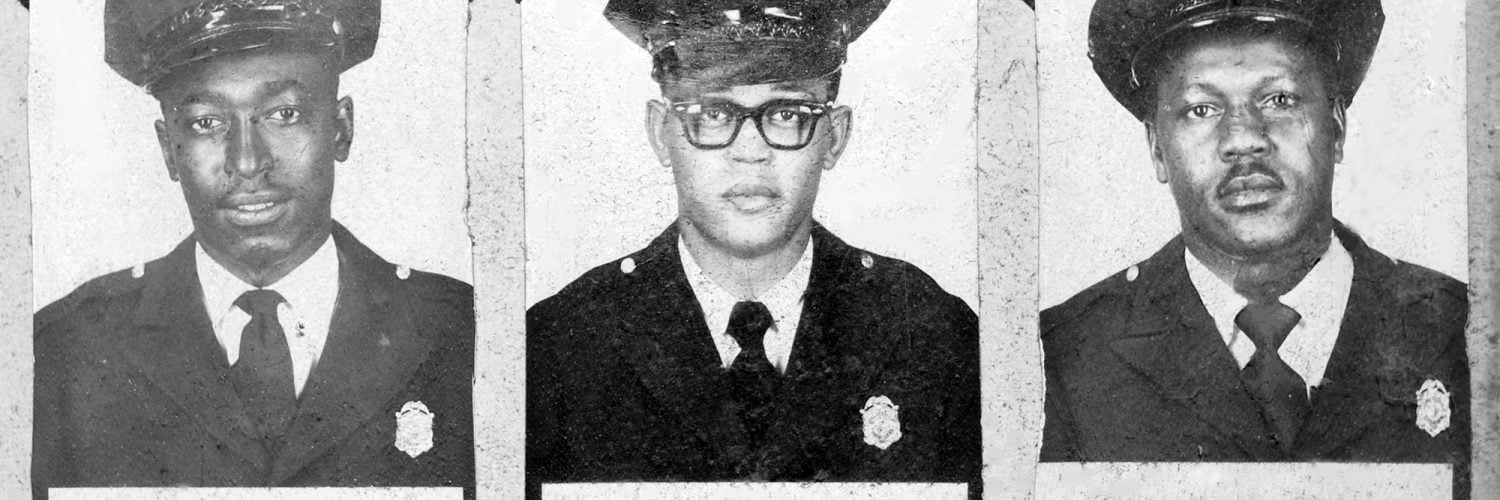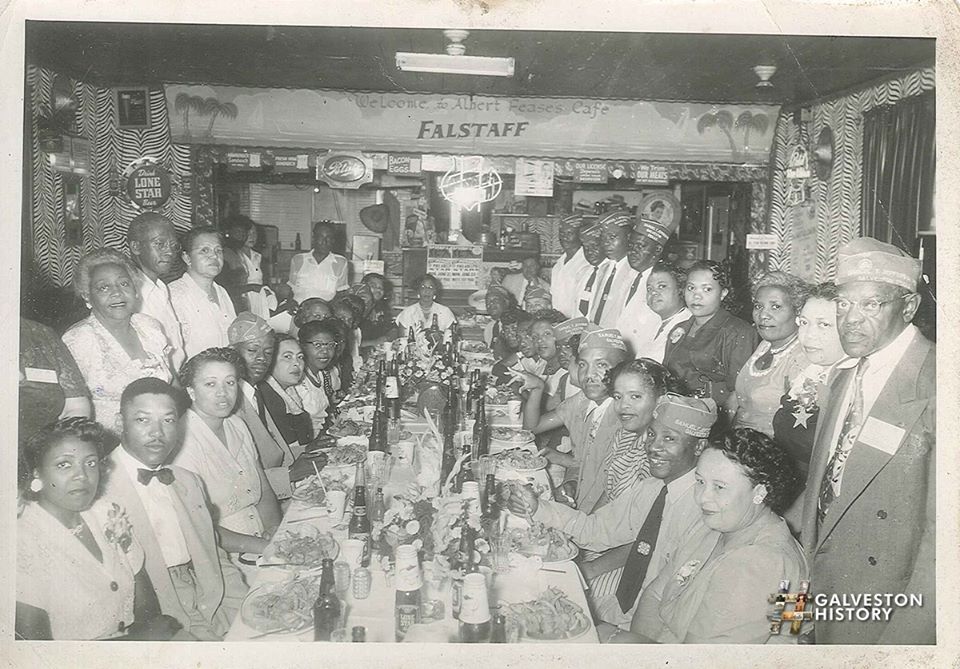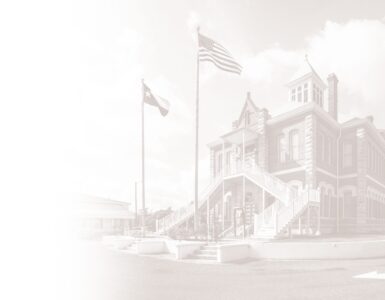It is essential that we recognize this history and place it in the forefront of our history. – Dwayne Jones, Galveston Historical Foundation Executive Director
Lost Restaurants of Galveston’s African American Community, written by members of GHF’s African American Heritage Committee will be available for purchase in Fall 2020. This excerpt is one of many stories focusing on the food, restaurants, and communities of Galveston’s African-American history.
Albert Fease was born in Lafayette, Louisiana on March 8th, 1911, and arrived in Galveston in the late 1920’s. In the early 1950s Fease opened the Albert Fease Café at 2820 Avenue R ½. A short time later the business moved to 2812 R ½ where it remained. After relocating, the establishment was renamed Jambalaya Beer. In 1955, the name of the business changed again, to the Jambalaya Café. Fease remained the proprietor for the duration of the business. Through his association with the café and community events, Fease left an indelible mark on the history of Galveston Island.
Fease’s Jambalaya Café was known for its famous stuffed shrimp, stuffed flounder, and gumbo, as well as jambalaya. In addition to seafood, the restaurant also served steaks and other short order dinners. Fease would always bring back wild game he shot on hunting trips to the café, where he served it to lucky customers. Fease’s café was also equipped for banquets and private parties. The Galveston Daily News recognized the restaurant in 1955 for its donation to the United Fund of Galveston.
Fease was also an avid sportsman. He enjoyed golfing, fishing and hunting, and won many awards participating in tournaments supporting his interests. Fease also served as a board member for the reorganization of the Gibson branch of the YMCA and was a member of the Knights of Pythias Dokas, the Galveston Isle Golf Association, and the Golftoppers Outdoor Sportsman’s Club. Fease attended Holy Rosary Catholic Church, the first African American Catholic church in the state of Texas.
In addition to running the café and participating in sports events, Fease owned and operated the Sinclair Service station at 2902 Seawall Boulevard, just one block west of the Café. The “full service” station, offered supreme gasoline, supreme motor oil, kerosene, washing, polishing, lubrication, and tire and battery service.
Fease was a well-rounded ambassador for the City of Galveston. He passed away at St. Mary’s hospital in Galveston, Texas on September 25th, 1981. His memory is still held in the highest regard by those who knew him and his substantial contribution to the rich history of Galveston Island will never be forgotten.

Formed in 1859, Star State Company No. 3 served as the third firehouse for the growing island. The 1900 hurricane, however, destroyed the original firehouse that the city constructed in 1860. The 1903 Firehouse No. 3 replaced the original but in a new location at 2828 Market. While the architect is not yet known, the building is a good and rare example of a civic firehouse of the late 19th and early 20th century. It is the only one remaining from the Victorian period on Galveston Island. Redbrick was used to create polychromatic exterior bands and added cast concrete decorative elements and multi-light windows typical of Victorian architecture. Original photographs show a handsome parapet and a balcony at the center of the principal façade. The 1915 hurricane damaged the building and removed some of the early architectural elements with a concrete facing placed on the building around 1950.

In 1957, Star State Company No. 3 became the first firehouse in the city to integrate with African American firemen. The city continued to use the building as a fire station until it was decommissioned in the 1960s. After its use as a firehouse ended, the city’s water department operated from there until it was later vacated and used for city storage. It was sold to 2828 Market, LLC in 2015 and GHF acquired the building in 2017.
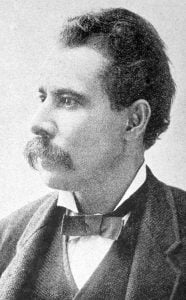 Norris Wright Cuney was born near Hempstead, Texas in 1846 to a prominent white plantation owner and a slave mother. At the age of 13, Cuney’s father sent him to a school for blacks in Pennsylvania. During the Civil War, with his education interrupted, Cuney traveled around the United States for several years eventually settling in Galveston where he studied law and became a well-known figure in Texas and at the national level. During his life, Cuney served as city alderman and was appointed a school director of Galveston County. He was the first Grand Master of the Prince Hall Masons in Texas from 1875 to 1877. In 1882, Cuney became special inspector of customs at Galveston and eventually collector of customs for the port in 1889.
Norris Wright Cuney was born near Hempstead, Texas in 1846 to a prominent white plantation owner and a slave mother. At the age of 13, Cuney’s father sent him to a school for blacks in Pennsylvania. During the Civil War, with his education interrupted, Cuney traveled around the United States for several years eventually settling in Galveston where he studied law and became a well-known figure in Texas and at the national level. During his life, Cuney served as city alderman and was appointed a school director of Galveston County. He was the first Grand Master of the Prince Hall Masons in Texas from 1875 to 1877. In 1882, Cuney became special inspector of customs at Galveston and eventually collector of customs for the port in 1889.
As an activist, politician and union leader, Cuney improved education for African Americans in Galveston and established a union for Galveston’s black dock workers. In 1879, Cuney was asked to lead the newly formed Cotton Jammers Association, a group of African American longshoremen who were denied entry into the Screwmen’s Benevolent Association, a group of specialized longshoremen who, with the aid of a tool called a “screwjack” packed cotton into the holds of ships.
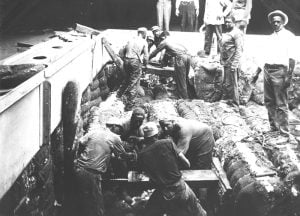 By 1882, Cuney was still unable to secure stevedoring contracts for the black longshoremen even through in peak seasons, there was a labor shortage. To break the white longshoremen’s monopoly on the wharves, Cuney brought over a large number of black longshoremen from New Orleans in 1883, giving him the workforce needed in order to gain the stevedoring contract from Morgan Lines, one of the port’s largest cotton shippers.
By 1882, Cuney was still unable to secure stevedoring contracts for the black longshoremen even through in peak seasons, there was a labor shortage. To break the white longshoremen’s monopoly on the wharves, Cuney brought over a large number of black longshoremen from New Orleans in 1883, giving him the workforce needed in order to gain the stevedoring contract from Morgan Lines, one of the port’s largest cotton shippers.
In March of 1883, Cuney organized the Screwmen’s Benvolent Assocation No. 2 and the president of the Galveston Cotton Exchange was informed that Cuney had both tools and an ample workforce. Their first job on the ship Albion resulted in an immediate withdrawal of all white workers and a strike was called by the white association. The white workers were brought back but it was not an overwhelming victory for the black workers as Cuney was still the only employer who hired the black workers throughout the 1880s and 1890s.
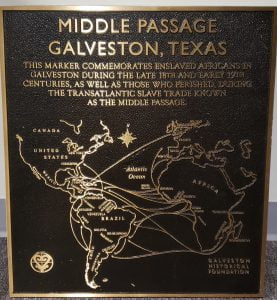 Nearly 12 million Africans were involved in the Middle Passage of the transatlantic human trade. GHF’s African American Heritage Committee in partnership with the the Middle Passage Ceremonies and Port Markers Project (MPCPMP) joined together in 2017 to honor these people with a special Middle Passage Marker.
Nearly 12 million Africans were involved in the Middle Passage of the transatlantic human trade. GHF’s African American Heritage Committee in partnership with the the Middle Passage Ceremonies and Port Markers Project (MPCPMP) joined together in 2017 to honor these people with a special Middle Passage Marker.
This marker commemorates enslaved Africans in Galveston during the late 18th and early 19th centuries, as well as those who perished during the transaltantic slave trade known as the Middle Passage.
ABOUT GALVESTON HISTORICAL FOUNDATION
Galveston Historical Foundation (GHF) was formed as the Galveston Historical Society in 1871 and merged with a new organization formed in 1954 as a non-profit entity devoted to historic preservation and history in Galveston County. Over the last seventy years, GHF has expanded its mission to encompass community redevelopment, historic preservation advocacy, maritime preservation, museum development, and heritage tourism. GHF embraces a broader vision of history and architecture that encompasses advancements in environmental and natural sciences and their intersection with historic buildings and coastal life, and continues to lead on local, state, and national levels with research-driven programs that build awareness of preservation’s role in cultural identity and stewardship across generations.


